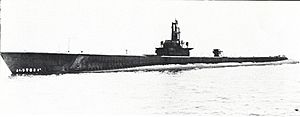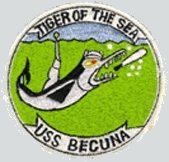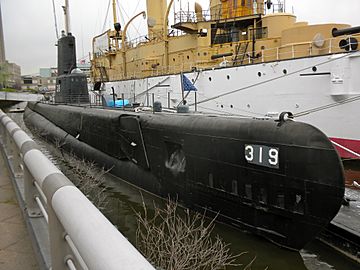USS Becuna facts for kids

USS Becuna (SS-319) after commissioning in May 1944.
|
|
| History | |
|---|---|
| Namesake | Becuna |
| Ordered | April 10, 1942 |
| Builder | Electric Boat Company, Groton, Connecticut |
| Laid down | April 29, 1943 |
| Launched | January 30, 1944 |
| Sponsored by | Mrs. George C. Crawford, wife of Commander Crawford |
| Commissioned | May 27, 1944 |
| Decommissioned | November 7, 1969 |
| Stricken | August 15, 1973 |
| Motto | Tiger of the Sea |
| Honors and awards |
4 Battle Stars |
| Status | Museum ship at Philadelphia, June 21, 1976 |
| Badge |  |
| General characteristics As built | |
| Class and type | Balao-class diesel-electric submarine |
| Displacement |
|
| Length | 311 ft 9 in (95.02 m) |
| Beam | 27 ft 3 in (8.31 m) |
| Draft | 16 ft 10 in (5.13 m) maximum |
| Propulsion |
|
| Speed |
|
| Range | 11,000 nautical miles (20,000 km) surfaced at 10 knots (19 km/h) |
| Endurance |
|
| Test depth | 400 ft (120 m) |
| Complement | 10 officers, 72 enlisted |
| Armament |
|
| General characteristics Guppy IA | |
| Class and type | none |
| Displacement |
|
| Length | 307 ft 7 in (93.75 m) |
| Beam | 27 ft 4 in (8.33 m) |
| Draft | 17 ft (5.2 m) |
| Propulsion |
|
| Speed |
|
| Range | 17,000 nmi (31,000 km; 20,000 mi) surfaced at 11 knots (20 km/h; 13 mph) |
| Endurance | 36 hours at 3 knots (5.6 km/h; 3.5 mph) submerged |
| Complement |
|
| Armament |
|
|
USS Becuna (SS-319)
|
|
| Lua error in Module:Location_map at line 420: attempt to index field 'wikibase' (a nil value). | |
| Location | Penn's Landing, Columbus Blvd. & Spruce St., Philadelphia, Pennsylvania, United States |
| Area | less than one acre |
| Built | 1944 |
| Built by | Electric Boat Co. |
| Architectural style | Balao-class submarine |
| NRHP reference No. | 78002458 |
| Added to NRHP | August 29, 1978 |
The USS Becuna (SS/AGSS-319) was a United States Navy submarine. It was named after the becuna, a fish similar to a pike found in Europe. This submarine was active from 1944 to 1969.
During World War II, the Becuna went on five important missions, called war patrols. These patrols took place between August 1944 and July 1945. The submarine operated in areas like the Philippine Islands, the South China Sea, and the Java Sea. It successfully sank two Japanese oil tankers.
After the war, the Becuna continued to serve. It was part of the United States Pacific Fleet until 1949. Later, it joined the United States Atlantic Fleet and was mainly used for training. It also traveled to the Mediterranean Sea twice.
Today, the Becuna is a special museum ship in Philadelphia, Pennsylvania. It was recognized as a National Historic Landmark because of its important service in World War II. You can visit it at the Independence Seaport Museum.
Contents
Building and Starting Service
The Becuna was built by the Electric Boat Company in Groton, Connecticut. Its construction began on April 29, 1943. The submarine was officially launched into the water on January 30, 1944. Mrs. George C. Crawford was its sponsor, a special role for a ship's launch. The Becuna was officially ready for service on May 27, 1944.
Service History
World War II Missions
Early Training: May–August 1944
After its initial tests and training near Naval Submarine Base New London, the Becuna left Groton on July 1, 1944. It arrived at Pearl Harbor, Hawaii, on July 29, 1944. There, the crew continued with more training exercises around the Hawaiian Islands.
First War Patrol: Hunting in the Pacific
The Becuna began its first war patrol on August 23, 1944. For a month, it searched the seas but only saw aircraft. On September 25, 1944, its lookouts spotted a group of three Japanese merchant ships with a destroyer escort. The Becuna dove underwater and fired six torpedoes. The crew heard an explosion while avoiding depth charges, but couldn't confirm any sinkings.
On October 9, 1944, the Becuna had its first confirmed success. It worked with another submarine, the USS Hawkbill (SS-366), to sink the Japanese cargo ship Tokuwa Maru. This ship weighed 1,943 tons. After this mission, the Becuna went to Fremantle, Australia, for repairs and resupply.
Second War Patrol: South China Sea Search
On November 16, 1944, the Becuna left Fremantle for its second war patrol. It sailed through the South China Sea, near the coast of Japanese-controlled French Indochina. The submarine was looking for Japanese warships. On December 23, 1944, it saw two Japanese cruisers. However, there wasn't enough time to get into a good position to attack before they entered Cam Ranh Bay.
The rest of this patrol was not very successful for sinking large ships. The Becuna did destroy some floating naval mines. On its way back to Fremantle, it used its deck gun to sink two small Japanese cargo ships. These were called "sea trucks" by the Americans. The submarine then had more repairs in Fremantle in January 1945.
Third War Patrol: Tanker Attack
The Becuna started its third war patrol in February 1945. It returned to the South China Sea. On February 22, 1945, it found a Japanese convoy near Cap Padaran. The submarine fired torpedoes at the tanker Nichiryu Maru and sank it. The Becuna then had to escape from 70 depth charges fired by two escort ships. It didn't find any other Japanese ships during this patrol. The mission ended when it arrived at Subic Bay in the Philippine Islands for more repairs.
Fourth War Patrol: No Sightings
In May 1945, the Becuna began its fourth war patrol from Subic Bay. This time, it did not spot any Japanese ships. It then traveled to Fremantle, arriving in early June 1945 for another period of repairs.
Fifth War Patrol: Final Missions
The Becuna left Fremantle for its fifth war patrol on June 21, 1945. During this patrol, Japanese floatplanes attacked it with bombs twice. On July 15, 1945, the submarine detected a fast-moving target in the Java Sea using its radar. It chased the target for hours and fired torpedoes, but they missed. Another submarine, the USS Baya (SS-318), then took over and sank the Japanese torpedo boat Kari.
The Becuna finished its patrol at Subic Bay in late July 1945. While it was getting repairs there, World War II officially ended on August 15, 1945.
After World War II: Training and Upgrades
The Becuna returned to the United States on September 22, 1945, arriving in San Diego, California. It then served in the United States Pacific Fleet until 1949. During this time, it helped train submarine crews and took part in various naval exercises. It also visited Japan and China.
In April 1949, the Becuna moved to the United States Atlantic Fleet. It was based in Groton, Connecticut, and mainly conducted training exercises. It often served as a school ship for students learning about submarines.
In November 1950, the Becuna went into the shipyard for a big upgrade. This was part of the GUPPY Program. It received new batteries, a submarine snorkel (a tube that lets the submarine run its diesel engines underwater), and a more streamlined sail (the tower on top of the submarine). These changes made it a GUPPY IA submarine.
The upgrades were finished in August 1951. The Becuna then did more training in the West Indies before returning to Groton in September 1951. For the next 18 years, it continued its training missions. It helped train future submarine commanders and provided services for testing new equipment. It also trained United States Naval Reserve personnel.
The Becuna also made two trips to the Mediterranean Sea to serve with the United States Sixth Fleet. It visited many ports there and participated in exercises with other navies. It also visited Scotland, other European ports, and ports in Canada and along the United States East Coast. In 1969, its classification changed to an auxiliary submarine, and its symbol became AGSS-319.
End of Service and Museum Life
The Becuna was officially taken out of service on November 7, 1969. It was then stored in the Atlantic Reserve Fleet in Philadelphia, Pennsylvania. In 1971, its symbol changed back to SS-319.
The Becuna stayed in reserve until August 15, 1973, when its name was removed from the official list of naval vessels. In 1976, it was given to the Cruiser Olympia Association to become a memorial.
Awards and Recognition
The USS Becuna received several awards for its service:
 Asiatic-Pacific Campaign Medal with four battle stars for its service in World War II.
Asiatic-Pacific Campaign Medal with four battle stars for its service in World War II. World War II Victory Medal
World War II Victory Medal Navy Occupation Service Medal with an "ASIA" clasp.
Navy Occupation Service Medal with an "ASIA" clasp. China Service Medal
China Service Medal National Defense Service Medal with one star.
National Defense Service Medal with one star.
A Museum Ship in Philadelphia
On June 21, 1976, the Becuna was placed on permanent display in Philadelphia. It is located next to the cruiser USS Olympia (C-6) at Penn's Landing. In 1986, the Becuna was named a National Historic Landmark.
Since 1996, both the Becuna and the Olympia have been managed by the Independence Seaport Museum. In 2001, the Becuna received an award for its historical welded structure from the American Welding Society.
See also


